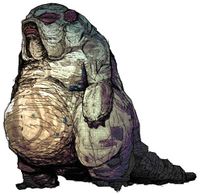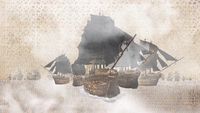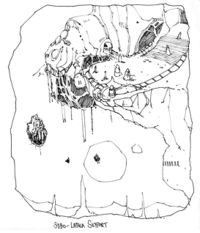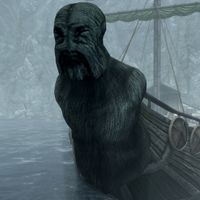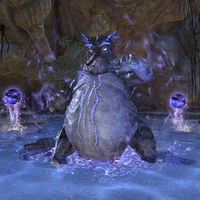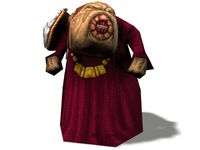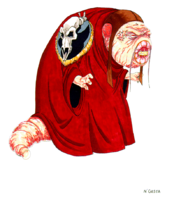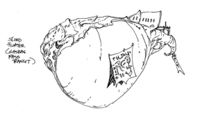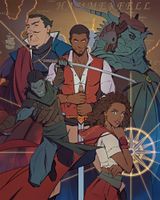Lore:Sload
This article is about the race. For the language, see Sload (language).
The Sload (sometimes called Slugmen,[1] slug-folk,[2] slug people,[3] grubs, or worms)[4][5] are a race of sluglike beastfolk native to the Coral Kingdoms of Thras, southwest of Tamriel.[6][7] They are infamous for releasing the Thrassian Plague upon Tamriel in 1E 2260, killing more than half of the population.
Contents
History[edit]

The Sload Coral Kingdoms have generally followed an isolationist policy, much due to being at war with the rest of Nirn, but they have had diplomatic relations with the Maormer of Pyandonea.[1] Therefore their history is not greatly known.
Early History[edit]
The Sload are in recorded history as early as the Early Merethic Era, when the Aldmer migrated from Aldmeris to Summerset.[8] They were said to occupy the Southern Sea.[9][10] The Sload of Thras may have been original inhabitants of Summerset as well,[6] as the oldest of all the ruins there are made of coral, thought to have been carried a great many miles away from the sea. The material and style of the ruins strongly suggest that the Sload may have once counted Summerset as a part of their kingdom of Thras.[11]
The Sload used necromantic magic and infernal machines to attack the Altmer since before recorded time, conjuring sea monsters along the coasts and capturing many Altmer, though they have never succeeded in reclaiming Summerset.[6] During the first of the Altmeri formwars, some Altmer took on aquatic forms to become dreughs and sieged the necromantic meatmerchants of Thras back into their misdesigned corals sandboxes.[12][UOL 1] An unnamed ship of Topal's fleet travelled north-west Summerset, towards Thras and Yokuda. It is thought that this ship and Pasquiniel may have perished at the hands of the ancient Sload, as they did not return.[13]
The sload visited horrors upon Summerset during the Sack of Skywatch in 1E 1301, capturing some Altmer to bring them back to Thras.[11] The few Altmer that escape mention being kept in a lagoon at the center.[6]
Thrassian Plague and Fall of the Sload[edit]
The Sload unleashed the Thrassian Plague in 1E 2200, which decimated more than half of Tamriel's population, particularly the western coastlands closest to Thras.[14][15] In an event known as the Fall of the Sload,[16] Bendu Olo, the Baron-Admiral of the All Flags Navy, led the largest allied naval force in Tamrielic history to Thras, slaughtered all the Sload they could find, and sunk their coral kingdoms into the sea with great unknown magicks.[17] While it's unknown when the disease fully subsided, cases of the Thrassian Plague were still being reported near Wayrest over four hundred years after its initial outbreak.[18] The effects of the Plague and the Fall were very impactful; Olo was thereafter known as the "dealer of swift justice" to the Foul Spot of Thras,[17] and the glory of the Cyrodilic people became known throughout the world.[14] Elsweyr was reduced from 16 down to 2 kingdoms,[19] Valenwood later fell to the Empire from being weakened by the plague,[20] and Hammerfell was on friendlier terms with its neighbors, all as a result of the Fall.[21]
Post-Sinking and Rise of Thras[edit]
The Sload were long presumed extinct after the Fall.[17] They recovered by the end of the era, and waged the War of the Uvichil from 1E 2911 to 1E 2917, regarded as one of the most terrible events in Tamriel's history.[11]
By 2E 864, Thras was considered a "free" or "wild region" by the Septim Empire, and it was reported that it had risen again. Imperial authorities encouraged citizens to report the existence of its masters, the Sload, if seen in the various areas of Tamriel.[17]
In 3E 120, maps of lands beyond Tamriel, including Thras, could be seen in the Map Room of the Blue Palace.[22] By the waning years of the Third Era, from 3E 402 to 3E 432, the western seas were very quiet and Agonio had become considerably great in size, giving hope to Tamriel that the Sload had retreated back to Thras for good.[6]
Following the Warp in the West in 3E 417, it was said that the Sload priests began talking to their new God of Worms.[UOL 2] Only a few Sload necromancers operated successfully in Black Marsh around 3E 427, and even then they were only active near the coast.[7] During the Mages Guild debate regarding outlawing Necromancy, Ulliceta gra-Kogg said necromancers are the scourge of Tamriel, whether operating independently or in concert with the sloads or King of Worms.[23]
Society and Culture[edit]
They are highly intelligent and skilled at magic,[17] and their mastery of necromancy is renowned.[6] They supposedly only practice Necromancy on other races, which some say explains the number of slaves they purchase in Tear, and the rumors of Sload airships carrying corpses from Senchal.[7] Said airships are known as Sload floaters, which are living gasbags, used for mass transit and warfare.[UOL 3][UOL 4]
Sload are innately cautious and careful, and in their mythic traditions their heroes spend years planning, considering and consulting with wise Sload before taking the correct action and achieving their goal. By contrast, their villains all act quickly or rashly and always fail. The Sload language has no word for 'adventure', and the closest equivalent more accurately means 'tragic disaster'.[17]
Sload do not seem to experience emotions as the Tamrielic races do, but are often skilled at acting and may exaggeratedly simulate them for the benefit of more emotive beings.[17] They will honor laws, loyalties, and friendships only as long as they calculate it to be in their best interests to do so. They also have no compunctions against blasphemy, theft, kidnapping, murder, genocide or anything else that may help them reach their goals.[17]
Sload are apparently not religious and generally reject worship, but will willingly serve Daedra if they benefit from it.[2] Some, in particular the famed Second Era necromancer N'Gasta, also follow the King of Worms.[UOL 2]
Due to their slippery grip, Sloads have eschewed the use of most tools. They do use armor on occasion, as their flabby bodies don't provide much natural protection. In these armors, they are known to use the shells of large nautiluses, cephalopods native to the waters around Agonio.[24] Despite their size, Sloads were known to engage in fencing. For example, they developed an intriguing regimen known as 'Welcoming the Cut.'[25]
Biology[edit]
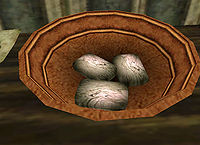
It is unknown exactly how Sload reproduce. They are believed to be hermaphrodites in their youths, though the sexual organs seem to be absorbed by the time they are old enough to survive on land.[26] Sload parents care little for the fate of the young, and will often kill them to make Sload Soap, which they use in necromantic rituals. Sload begin their lives as "disgusting little amorphous grubs" according to Bendu Olo, leader of the punitive expedition sent by Tamrielic nations to Thras after the Thrassian Plague. The young Sload mutate into aquatic quasi-cephalopods called "polwygles" before they reach adulthood.[1] Sloads are thought to be incapable of having mixed offspring with Man, Elves, and other Beastfolk, as such are not considered to be human.[27]
Due to the corpulence of the adult Sload's slug-like humanoid body, they are said to spend much of their time wallowing in shallow lagoons and move very slowly.[1] Though according to another, while slow elsewhere, the buoyant Sload move about with relative quickness and grace in the brackish lagoon at the center of the Thras island chain, through an intricate network of coral formations and ancient shipwrecks.[6] The integument of Sload can slowly adapt to objects and surfaces, which allows them to climb surfaces like slugs.[17]
Sea Sload[edit]
Sea Sload are a species of Sload that are known to be even more reclusive than their Thrassian cousins. They are known to rule realms in the Sea of Pearls, with one such realm being the undersea kingdom of Ul'vor Kus. In addition to necromancy, the Sea Sload are also skilled in the arts of alchemy, shadow magic, and mind magic, as well as other arcane disciplines.
Unlike regular Sload, which organize themselves in small kingdoms, Sea Sload often tend to form cabals among themselves to achieve common goals, which then break up or reform as those goals change. They utilize various deep sea creatures as servants and soldiers, which they address through a combination of the guttural Sload language and mind magic. The yaghra, which were created from crustacean-like bottom feeders, are their most common servants. Yaghra Striders appear to revere the Sea Sload as their gods.
Gallery[edit]
Notes[edit]
- "Sload" is a portmanteau of "slug" and "toad".
- "Sload-marched" was an idiom used by some to describe taking someone somewhere by force,[28] a play on the term "frog-marched".
- A ship in the Fourth Era was named the Dainty Sload after the Sload.[29]
See Also[edit]
- Sload Names
- For a list of notable Sloads, see here.
- For game-specific information, see the Elder Scrolls Online
 article.
article.
Books[edit]
- A Loathsome Civilization by Telenger the Artificer — A scholar's research notes on the Sload
- Further Notes on the Sload by Telenger the Artificer — A noted scholar discusses the sload and their soap in some detail
References[edit]
- ^ a b c d Further Notes on the Sload — Telenger the Artificer
- ^ a b A Loathsome Civilization — Telenger the Artificer
- ^ Guide Culast's dialogue in ESO
- ^ Grub Druglord concept art for Morrowind
- ^ N'Gasta's dialogue in Redguard
- ^ a b c d e f g Pocket Guide to the Empire, 3rd Edition: Other Lands — Imperial Geographical Society, 3E 432
- ^ a b c Corpse Preparation
- ^ Auridon Explored, Chapter XII — Fenlil the Wayfarer
- ^ The Lay of Firsthold
- ^ Serpent's Grotto loading screen in ESO
- ^ a b c Pocket Guide to the Empire, 3rd Edition: The Blessed Isle: Alinor and the Summersets — Imperial Geographical Society, 3E 432
- ^ The 36 Lessons of Vivec — Vivec
- ^ Father of the Niben — Florin Jaliil
- ^ a b Pocket Guide to the Empire, 1st Edition: Cyrodiil — Imperial Geographical Society, 2E 864
- ^ Pocket Guide to the Empire, 3rd Edition: All the Eras of Man, A Comprehensive History of our History — Imperial Geographical Society, 3E 432
- ^ Varieties of Faith... — Brother Mikhael Karkuxor of the Imperial College
- ^ a b c d e f g h i Pocket Guide to the Empire, 1st Edition: The Wild Regions — Imperial Geographical Society, 2E 864
- ^ Wayrest, Jewel of the Bay — Sathyr Longleat
- ^ Pocket Guide to the Empire, 3rd Edition: Sugar and Blood: the Cats of the South — Imperial Geographical Society, 3E 432
- ^ Pocket Guide to the Empire, 3rd Edition: The Wilds Remain: Valenwood — Imperial Geographical Society, 3E 432
- ^ Pocket Guide to the Empire, 3rd Edition: The Ra Gada: Hammerfell — Imperial Geographical Society, 3E 432
- ^ The Wolf Queen, v5 — Waughin Jarth
- ^ The Black Arts On Trial — Hannibal Traven, Archmagister of the Mages Guild
- ^ Nautilus Shell Guards item description in ESO
- ^ Lord Fa-Nuit-Hen and Tutor Riparius Answer Your Questions 2 — Fa-Nuit-Hen and Tutor Riparius
- ^ Notes on Racial Phylogeny — the Council of Healers, Imperial University
- ^ Dialogue in Morrowind
- ^ Lozruth's dialogue in ESO
- ^ Dainty Sload in Skyrim
Note: The following references are considered to be unofficial sources. They are included to round off this article and may not be authoritative or conclusive.
- ^ How Beautiful You Are That You Do Not Join Us
- ^ a b Skeleton Man's Interview with Denizens of Tamriel
- ^ Sload Floater and Skyport concept art
- ^ Nemon's Memorystone — Nemon
|
|||||||||||||||||||||||||||||||||||||||||
